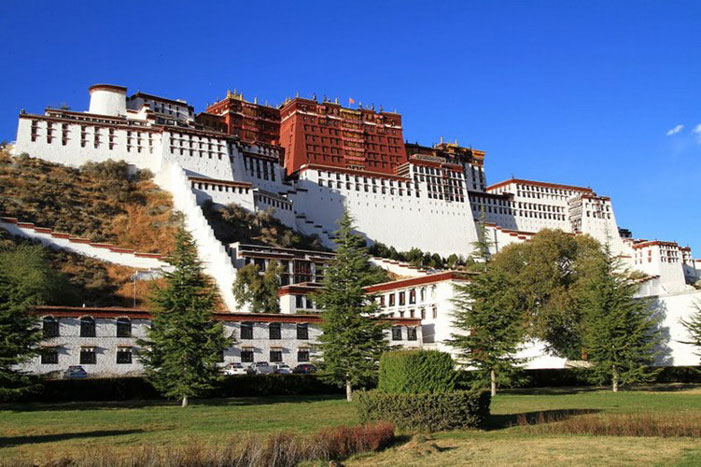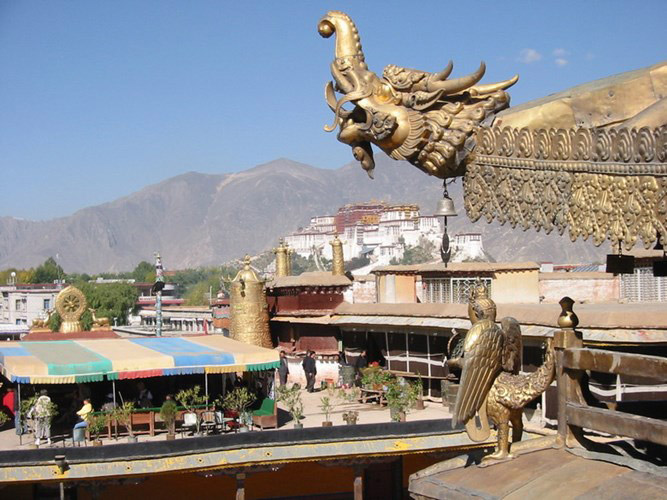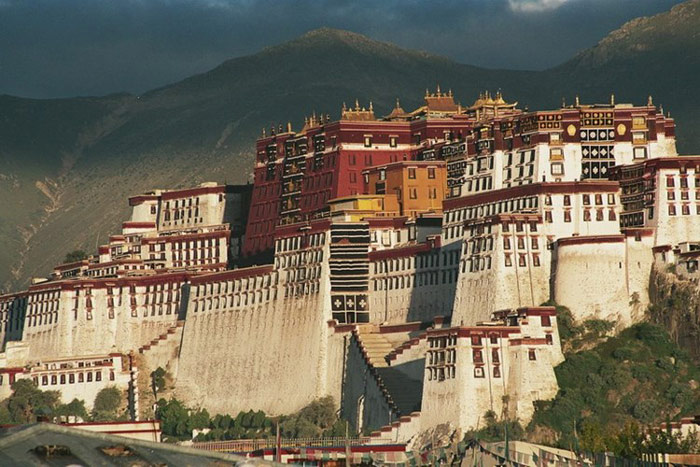Potola Palace of China
Unesco's Scientific, Educational and Cultural Organization has recognized Potola Palace as a World Cultural Heritage in 1994.
Potala Palace - Tibetan Buddhist symbol
The Potola Palace is located on the Hong Son mountain in the center of Lasa city in China's Tibet Autonomous Region. The entire architectural cluster is built on cliffs, massive scale, magnificent magnificent, is considered 'the jewel on the roof of the world '. This is a typical work of Tibetan architecture and is also one of the famous ancient architecture in the world.

The Potola Palace is a place of political, religious and residence of Tibetan lamas and is the largest surviving ancient high-rise architecture of Tibet. According to historical records, the first Potola Palace was built in the 7th century, during which time it was called Cung Hong Son . The scale of the palace is very large, outside there are three layers of walls, inside there are thousands of spaces and the political center of the Tuphan dynasty. In the 9th century, the Tuphan court was dissolved and Tibet was in a period of war, the population of Hong Son was abandoned.

Until the beginning of 1654, the 5th Lama was able to rebuild Potola supply. This project was built in 50 years to get the current scale. Outside the palace of Potola 110 meters high with 13 floors. The structure of Potola supply is made of stone and wood, the entire wall is covered with marble, 5 meters thick, the wall is firmly reinforced deep down many layers of soil to the lava layer and even poured steel into the middle of the class to increase the overall and the shocking ability of the architecture. The roof of the palace is decorated with gold and skillfully processed to avoid damage and lightning move time. Several hundred years passed, the Potola palace has experienced many earthquakes, challenges of storms but still majestic and stable. Potola Palace has the main power of the White Palace, the Red Palace and the white suites of monks . In front of the Red Palace is a hotbed of statues and pictures of Buddha painted in white, during the Buddhist New Year here, it is used to hang Buddha paintings with a giant Buddha carpet often displayed here.

Although there are many areas in the overall Potola Palace built under different periods, most of them are built on very clever cliffs , making the whole building to build this pagoda into a magnificent master, magnificent, very harmonious, intact, reaching a very high level of aesthetic and architectural achievements.

The Red Palace is the subject of both this architectural cluster and the stupa of the Lama and the Buddha. In it, the spirit of the tower of Dat Lai 5th Phosangchia was built the most sophisticated. Linh tower is nearly 15 meters high, square foundation, circular roof divided into three parts is located tower, soldier tower, top tower. Dai Lat after death is placed at the tower of the tower along with aromas and roses. The body of the tower is covered with gold kneeling, a total of 3,724 kg of gold and 15,000 diamonds, red green gems, jade, pearls and agate are used.
The largest electricity in the west is the largest in the Red Palace, built with 48 large pillars, columns higher than 6m. The structure of the tower was built according to the structure of the formation - an architecture often found in the Han people. After the Potola supply was built in the 17th century and expanded in the following years, hundreds of thousands of frescoes also gradually appeared due to excellent artists in the area. In large and small electricity, doors, walkways and corridors hang everywhere. The content of the works is also very diverse and rich from historical stories, historical figures, stories of Buddhist scriptures, some of which convey the contents of activities, fun and entertainment activities . These are high-value works of art of Potola.

In addition to frescoes, the Potola Palace also houses more than 10 scrolls from the 17th century to the present. Many stone carvings, carved woods, earthen art statues and many traditional handicrafts of the Tibetan people are also displayed here. All architectures or objects in the Potola supply have a very high artistic value, they also reflect the long history of travel and friendship between the Han ethnic groups and the Tibetan nation throughout. over 1000 years. The 'jewel on the roof of the world' in terms of layout and earthwork. Carpentry, metallurgy, painting, sculpture of Potola palace are well-known in the world, demonstrating the superior technology of carpenters belonging to the ethnic groups of Tibet, Han, Mongolia, Ma. Among them, the Tibetan people make the main and achievements of the Tibetan architecture art.














- Ruins of Qin Shihuang Palace surfaced on the beach
- Admire the 10 most magnificent palaces in the world
- Discover the world's largest gold-plated palace of the king of Brunei
- Explore the magnificent Royal Palace of Japan
- The truth about inner wells: No one dares to drink water for fear!
- The Crystal Palace - The Crystal Palace
- 4 periods of heavenly action in the Forbidden City
- Xiang Yu's thousands of years of unjustness
- Uncover the mystery of childbirth in the old palace ban
- Palace of 1,000 years of the Khin dynasty in China
- Find the palace of Ode in the epic of the Morning
- Discovering vestiges of the palace during the Le So period in Thang Long Citadel
 Suzhou classic bonsai garden - China
Suzhou classic bonsai garden - China Chau Nguyen Dynasty
Chau Nguyen Dynasty Thai Son Mountain - World Wonder
Thai Son Mountain - World Wonder Ancient villages of Shirakawa-go and Gokayama
Ancient villages of Shirakawa-go and Gokayama Discover the life of concubines in the Tang Dynasty's 'harem'
Discover the life of concubines in the Tang Dynasty's 'harem'  Visit the palaces where the current kings and queens of the world are still living today
Visit the palaces where the current kings and queens of the world are still living today  Palace maidens can't give birth or get married after leaving the palace: In addition to dangerous diseases, there are also reasons for these reasons
Palace maidens can't give birth or get married after leaving the palace: In addition to dangerous diseases, there are also reasons for these reasons  Decipher the place rumored to cause the death of 28 queens in the Forbidden City
Decipher the place rumored to cause the death of 28 queens in the Forbidden City  Why is the bodyguard not as pure as the eunuch?
Why is the bodyguard not as pure as the eunuch?  Ancient palace maids were forced to sleep on their side: The real reason why everyone is angry!
Ancient palace maids were forced to sleep on their side: The real reason why everyone is angry! 